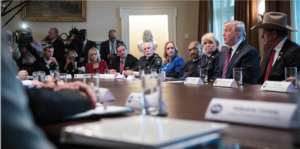On December 22, after Congress failed to pass a spending package granting President Donald Trump P’00 the $5.7 billion he demanded for border security, the U.S. government partially shut down. Nearly a month later, the government finds itself facing the longest shutdown in U.S. history.
President Trump insists that the shutdown will continue until the Democrats replace the $1.3 billion they’ve approved for border security with the sum he demands, and that, in the meantime, federal workers “will adjust.” Yet in the end, the shutdown easily could have been avoided, along with the financial harm it has done to 800,000 government employees and their families, as they approach one month without payment.
Under the guise of a “border crisis,” President Trump has prolonged the shutdown for his best interests rather than those of the people. Many border security experts deem the wall unnecessary and ineffective because the border patrol already manages to keep illegal immigrants out of the country rather efficiently. But, when pressured by criticism from the right wing, President Trump has strove to fulfill his futile campaign promise of a wall — the funding for which could be used for more practical and significant aspects of immigration reform, such as quicker consideration of asylum claims.
President Trump must consider public opinion in addition to this rationale before resisting compromise with Congress; a recent poll conducted by Ipsos/Reuters reported that only 25% of Americans support the shutdown and a mere 35% back including money for the wall in a spending bill. Still, on January 2, President Trump once again rejected a compromise proposal for the wall funding, further demonstrating his unwillingness to reach an agreement with Congress.
Rather than wielding his power to force the government into a stalemate, President Trump must work to improve immigration policies while recognizing the consequences of the shutdown on federal workers and agencies. Eight hundred thousand federal employees are currently working without pay; for those who rely on each paycheck, the government shutdown entails heavy ramifications. It reflects a blatant disregard for the welfare of the federal workforce. The financial stability of federal employees should not be compromised because of a government dispute, and they should receive their paycheck regardless of the shutdown. At the same time, government operations such as the Departments of Transportation, Agriculture, and Justice do not receive funding during the shutdown, resulting in a temporary closure of food inspections, State Department services, and the Internal Revenue Service (IRS), among others, which is also unacceptable. Even our Transportation Security Administration (TSA) workers are working without pay, provoking many employees to call in sick and delay security processes at the airport.
President Trump should push for effective legislation, reconcile disagreements in Congress, and introduce ideas that truly have the power to benefit the United States. Instead, he has opted to selfishly reject compromise at the cost of federal workers’ well-being. Democrats and Republicans alike are willing to address the issue of immigration — but it is impossible to take a truly productive course of action when President Trump refuses to consider all options for humane and reasonable border security. As he considers declaring a national emergency at the border, and thereby taking money from the military budget to fund the wall, the issue of legality arises. Will President Trump have exceeded his authority? What exactly qualifies as a national emergency? The number of illegal crossings has decreased in recent years; in 2008, over 1.6 million illegal immigrants were apprehended by the U.S. Border Patrol at the Southern border, whereas only 400,000 were apprehended in 2018. This means that most people would not consider the United States to be in an intense “border crisis” because we’re experiencing significantly less illegal immigration than in the past.
No obvious solution exists to the current government shutdown, but action can be taken to work toward preventing such stalemates. Until the government reaches some consensus, the federal workforce will continue to suffer as pawns of this misguided shutdown.





